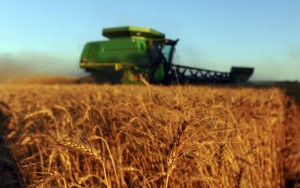 Grains futures were relatively steady during early trade in Europe today, with wheat recovering some losses, while beans and corn were deeper into the negative. The US Department of Agriculture (USDA) released weekly data on crops yesterday, which pressured all grains.
Grains futures were relatively steady during early trade in Europe today, with wheat recovering some losses, while beans and corn were deeper into the negative. The US Department of Agriculture (USDA) released weekly data on crops yesterday, which pressured all grains.
Weather patterns project more storms and rains for the Northern Plains and the whole Midwest, which would keep adequate-to-surplus soil moisture, favoring growing crops. Meanwhile, the South Plains may also see some rains and thunderstorms, which could hurt winter wheat quality and harvest progress, though some dry and sunny days are expected this week. The Delta will see warm and dry weather, which will help the winter wheat harvest.
The USDA’s National Agricultural Statistics Service (NASS) released its report on crops progress and quality for the week through June 15 yesterday. The log revealed steady improvement throughout, with winter wheat harvest advancing and good crops condition across all grains.
“Ratings are awfully good,” Mike Krueger, the president of The Money Farm in Harwood, North Dakota, said in a telephone interview. “The crop’s in the ground, it looks good, and it’s probably going to get better.”
Wheat
Wheat futures for July delivery on the Chicago Board of Trade stood at $5.830 per bushel, adding 0.34% at 9:25 GMT today. Daily high and low were at $5.846 and $5.810 per bushel, respectively. The contract dropped 0.85% yesterday, reaching a three-month low at $5.802 per bushel, after a 5% loss last week.
The NASS report showed 16% of winter wheat crops had been harvested by June 15, after 9% were logged last week. 30% of crops were in good or excellent condition, while 44% were in poor or very poor, which is on par with readings from previous years.
“We are talking about a higher base now,” Jammie Penm, chief commodity analyst at Abares, said for Bloomberg. “Certain parts of the wheat producing region in the U.S. have had less than favorable seasonal conditions. We’re closely monitoring the situation, but we have factored in some of the possible impacts.”
Spring wheat emergence rate was recorded at 91%, while quality remained quite good, with 72% of crops reported in good or excellent shape.
Corn
Corn futures for July traded for $4.402 per bushel, down 0.17%. Prices reached a daily high and low at $4.414 and $4.400 per bushel, respectively, reaching a four-month low. Yesterday the contract dropped 1.34%, after a further 2% loss last week.
Readings in the NASS report pointed a 97% emergence for corn crops by June 15, which is in line with the 5-year average. Meanwhile, 76% of crops were in good or excellent condition, well ahead of the 64% reading for the same week of the previous year. Only 4% of crops were reported in poor or very poor condition.
Corn declined “after a stronger-than-expected U.S. crop report,” Australia & New Zealand Banking Group Ltd. analysts including Paul Deane wrote in a note today, cited by Bloomberg. Data showed an improvement on “an already strong crop,” they said.
Soybeans
Soybean futures for July traded for $14.160 per bushel, dropping 0.40%. Prices ranged between $14.252 and $14.120 per bushel. The contract declined by 0.28% yesterday, after a 2% drop last week, when a three-month low at $14.100 per bushel was reached.
The NASS log revealed beans planting was nearing completion at 92%, after a 87% standing for last week. Emergence rate was at 83%, ahead of the 77% average for the past five years. Meanwhile, 73% of crops were said to be in good or excellent condition, also significantly more than last year.
“For most areas, the rainfall activity that we have been seeing has been pretty beneficial for the corn and [soy]bean development, thats for sure,” said for Reuters David Streit, meteorologist with Commodity Weather Group. “Its hard to come up with any issues as far as the corn and beans are concerned.”
Technical view
According to Binary Tribune’s daily analysis, wheat for July delivery on the CBOT will see its first resistance level at $5.903. If breached, the contract will advance to $5.997 and then to $6.047 per bushel. The first support points is estimated at $5.759. Should it be broken, wheat will test $5.709 and after that $5.615 per bushel.
Corn for July will have its first resistance at $4.469 and if it broken the contract will advance first to $4.527 and then to $4.561 per bushel. The first support level is calculated at $4.377. Should the contract breach that, it will probably continue down to $4.343. If both previous supports are penetrated corn will test $4.285 per bushel.
Soybeans for July have the front resistance level estimated at $14.322. If the contract manages to pass the first level, next resistance is expected at $14.428 and then $14.502 per bushel. Meanwhile, support is expected at $14.142, $14.068 and $13.962 per bushel.





